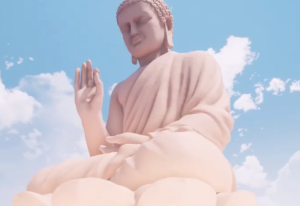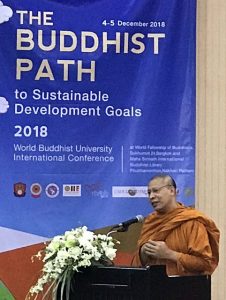
As much as I have appreciated my recent correspondence with my friend and fellow philosopher Amod Lele on the Sigalovada Sutta and the householder life, I wish to turn this month to a topic we discussed long ago, this one regarding the nature of the Dhamma—or dhammas—and morality in early Buddhist texts. However, as we’ll see, the topic of the householder life will return at the end of this article.
We began the discussion by describing the Dhamma in terms of lawfulness. It isn’t lost on most historians of religion that early translations of the Dhamma into English were made by British civil servants, often holding training in law. So perhaps, under further scrutiny, the idea of the Dhamma as law will not hold up—pun intended.
A second understanding of the Dhamma can be found in its verbal root √dhr, meaning to uphold or sustain. In the Brahmanical tradition contemporary to the Buddha, this would have referred to one’s duties, based on class, and the cosmos itself. This idea was not universal among Brahmins in the Buddha’s age, as the Upanishads—dated to the eighth to sixth centuries BCE—emphasized the importance of meditation as a path to release from samsara.
The Buddha in one sense maintained an understanding of the Dhamma as a sort of underlying law or objective Truth of things. The eminent scholar-monk Bhikkhu Bodhi expresses this clearly:
The Dhamma, in its broadest sense, is the immanent, invariable order of the universe in which truth, lawful regularity, and virtue are inextricably merged. This cosmic Dhamma is reflected in the human mind as the aspiration for truth, spiritual beauty, and goodness; it is expressed in human conduct as wholesome bodily, verbal, and mental action.
(Bodhi 108)
Bodhi here astutely connects the Buddhist idea of the Dhamma and the moral world within us. A mistake is often made by translators or contemporary readers when they see passages about the Dhamma. They see it as external, as a law or foundation outside of humans and human experience. Much of moral philosophy consists of debates about where morality comes from. Internalists point to inward impulses or feelings, while externalists look at societal rules, education, or divine revelation.
But the Buddha’s teaching is one which always seeks to collapse the internal-external divide and the debates to which it gives rise. The Buddha’s teaching instead focuses on experience, or phenomenology as the start and location of morality. Here, there is no internal versus external. Only with the arising of discursive thought do those divisions arise.
Nonetheless, a passage often cited to show the foundational or objective nature of the Dhamma (or dhammas) is the Paccaya Sutta (SN II.25), which states:
Whether the Tathāgatas [Buddhas] arise or the Tathāgatas do not arise, that condition stands, the groundedness of the Dhamma, the lawfulness of the Dhamma, this causality. A Tathāgata gains highest awakening to this and understands it.
This can be read as an externalist approach to ethics, and if taken in isolation might make the Buddha appear to be an externalist. However, as Prof. Richard Gombrich has pointed out, going back to those early Brahmanical teachings, there was always an internal connection to the external reality. (Gombrich 141)
The Buddha makes the image of fire central to his teachings, stating that the aggregates of our experience are all on fire. And fire, Gombrich notes, is not a thing but a process. (Gombrich 124) With this in mind, the Paccaya Sutta might be read as pointing to the process of realizing that all is in flux. The Buddha is not awakened to a metaphysical concept, but to a phenomenological reality.
The rest of us, unfortunately, are ignorant of that reality, instead living in a world of concepts that parse up reality into discrete things inside and outside. (Gombrich 149) For us, words can trap us in these divisions. And yet words are also the tools we use to extricate ourselves.
While trapped, however, we need guidance from those who know the path better than we do. As Bhikkhu Bodhi notes, we might think of two spheres of Dhammic embodiment—spiritual in the form of the Buddha and secular in the form of the wheel-turning monarch. The idealized monarch represents the best guide and leader we could hope for in the secular world, while the Buddha represents the perfection of the spiritual path.
Neither the wheel-turning monarch nor the Buddha creates the Dhamma they uphold, yet neither can perform their respective functions without it; for the Dhamma is the objective, impersonal, ever-existent principle of order that serves as the source and standard for their respective policies and promulgations.
(Bodhi 108)
The Buddha represents the spiritual ideal within the world of our experience. It is in some ways an other world but not in any metaphysical way. The Buddha’s reality and ours is the same, except that he and other awakened beings perceive it correctly.
The Buddha, in this way, has pragmatically transcended our ordinary categories. This is elucidated in the Dona Sutta (AN 4.36), in which the Brahman Dona asks the Buddha about who or what he is—a human, a deva, a celestial being? No, the Buddha answers, he is none of these ordinary categories. He is awake.
The Buddha offers the simile of the lotus flower. Just as a lotus flower blooms, blue, red, or yellow, having emerged from the muddy water of the pond unstained, so to the Buddha is unstained by the world.
Morally speaking, the Buddha is one who has inhabited entirely the moral standpoint. He is no longer clouded by egotistical impulses or desires and can directly and spontaneously act to help those around him. This is the goal of the holy life.
Living as a householder who strives to live the holy life is, no doubt, a challenge. The Buddha even at times held up the monastic life as the ideal. But he also formed the fourfold sangha, complete with laymen and laywomen, to establish his dispensation. And progress along the way is no less possible in practice with family commitments. Indeed, as many monastics find out, the ordained life is not necessarily easy or supportive of moral, meditative, and philosophical growth and practice. For those of us on the path as laypeople, there is no limit to the work that can be done to do good and purify our minds. And there is no limit on the progress that we can make.
References
Bodhi, Bhikkhu. 2005. In the Buddha’s Words: An Anthology of Discourses from the Pāli Canon. Somerville, MA: Wisdom Publications
Gombrich, Richard. 2009. What the Buddha Thought. London: Equinox.
Thanissaro Bhikkhu, trans. 2013. “Paccaya Sutta: Requisite Conditions” (SN 12.20), Access to Insight (BCBS Edition). http://www.accesstoinsight.org/tipitaka/sn/sn12/sn12.020.than.html
See more
The dhamma is not a transcendent law (The Indian Philosophy Blog)
Related features from BDG
Why Enlightenment?
The Buddhist Code of Discipline for Householders: An Online Discussion with Buddhist Scholars
Dudjom Lingpa
Book Review: Chenxing Han’s Be the Refuge
How Does the Buddha Relate to Ordinary Beings?
Retreating into the World: the Ultimate Spiritual Practice












